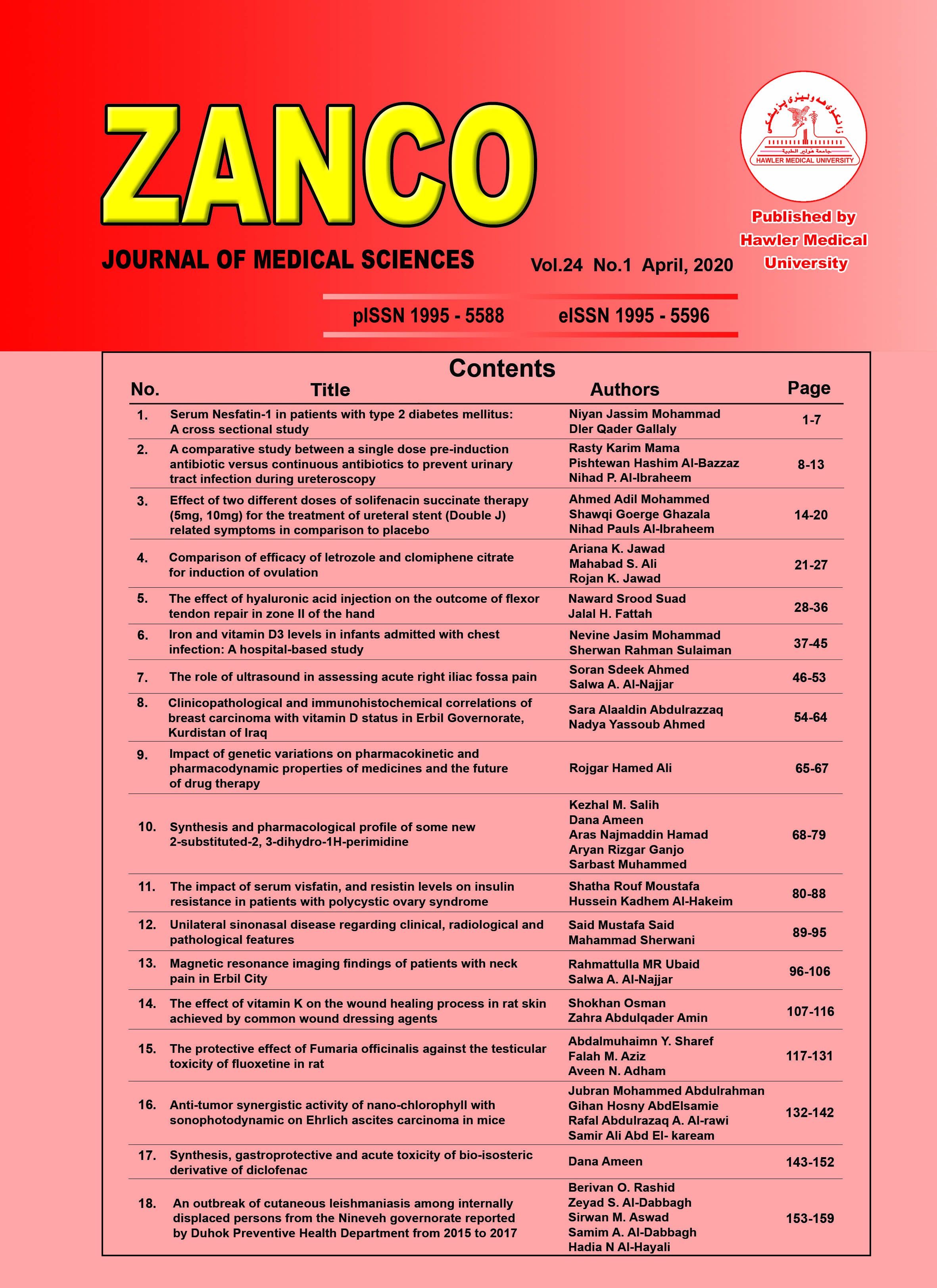A comparative study between a single dose pre-induction antibiotic versus continuous antibiotics to prevent urinary tract infection during ureteroscopy
Copyright (c) 2020 Rasty Karim Mama, Pishtewan Hashim Al-Bazzaz, Nihad P. Al-Ibraheem (Author)

This work is licensed under a Creative Commons Attribution-NonCommercial-ShareAlike 4.0 International License.
- Articles
- Submited: June 1, 2020
-
Published: April 30, 2020
Abstract
Background and objective: This study aimed to evaluate the effect of adding postoperative antibiotics in reducing the incidence of symptomatic urinary tract infections following ureteroscopic stone treatment beyond the recommended preoperative dose.
Methods: This prospective comparative study was conducted between March and November 2017. A total of 80 patients with preoperative negative urine cultures who underwent ureteroscopy were randomly allocated. All the patients received a single dose antibiotic before the induction of anesthesia, and a group of them also received postoperative antibiotics. The rate of symptomatic urinary tract infection was compared between the patients who received only preoperative antibiotics (group 1) and those who received pre- and postoperative antibiotics (group 2).
Results: Eighty patients underwent ureteroscopy for stone treatment. The time to follow up was 4±2 weeks from ureteroscopy. Eleven (13.8%) patients in total developed urinary tract infections postoperatively, including five (12.5%) from group 1 and six (15%) from group 2, P = 0.74. In group 1, four patients presented with cystitis and one with sepsis; those patients with infections in group 2 presented with pyelonephritis (n=2) and cystitis (n=4). Risk factors such as preoperative stenting, nephrostomy tubes, and Foleys catheters did not differ between groups.
Conclusion: The postoperative symptomatic urinary tract infection rate in this study (13.8%) is in agreement with previous reports. This study suggests that a single preoperative dose of antibiotics is sufficient, and additional postoperative antibiotics do not decrease infection rates after ureteroscopic stone treatment.
Metrics
References
- Fourcade RO. Antibiotic prophylaxis with cefotaxime in endoscopic extraction of upper urinary tract stones: a randomized study. The Cefotaxime Cooperative Group. J Antimicrob Chemother 1990; 26(Suppl A):77–83.
- Grabe M. Controversies in antibiotic prophylaxis in urology. Int J Antimicrob Agents 2004; 23(Suppl 1):S17–23.
- Geavlete P, Jecu M, Geavlete B, Multescu R, Nita G, Georgescu D. Ureteroscopy—An essential modern approach in upper urinary tract diagnosis and treatment. J Med Life 2010; 3:193–9.
- Urban JA. Cost analysis of surgical site infections. Surg Infect (Larchmt) 2006; 7(Suppl 1):S19–22.
- Gonen M, Turan H, Ozturk B, Ozkardes H. Factors affecting fever following percutaneous nephrolithotomy: A prospective clinical study. J Endourol 2008; 22:2135–8.
- Sharifi AF, Akhavizadegan H, Aryanpoor A, Inanloo H, Karbakhsh M. Fever after percutaneous nephrolithotomy: Contributing factors. Surg Infect (Larchmt) 2006; 7:367–71.
- Chen L, Xu QQ, Li JX, Xiong LL, Wang XF, Huang XB. Systemic inflammatory response syndrome after percutaneous nephrolithotomy: An assessment of risk factors. Int J Urol 2008; 15:1025–8.
- Wolf JS, Bennett CJ, Dmochowski RR, Hollenbeck BK, Pearle MS, Schaeffer AJ, et al. Best practice policy statement on urologic surgery antimicrobial prophylaxis. J Urol 2008; 179(4):1379–90.
- Knopf HJ, Graff HJ, Schulze H. Perioperative antibiotic prophylaxis in ureteroscopic stone removal. Eur Urol 2003; 44:115–8.
- Ramaswamy K, Shah O. Antibiotic prophylaxis after uncomplicated ureteroscopic stone treatment: Is there a difference? J Endourol 2012; 26:122–5.
- Preminger GM, Tiselius HG, Assimos DG, Alken P, Buck C, Gallucci M, et al. 2007 Guideline for the management of ureteral calculi. Eur Urol 2007; 52:1610–31.
- Pricop C, Dorobat C, Puia D, Orsolya M. Antibiotic prophylaxis in retrograde ureteroscopy: What strategy should we adopt? Germs 2013; 3:115–21.
- Moltzahn F, Haeni K, Birkhauser FD, Roth B, Thalmann GN, Zehnder P. Peri-interventional antibiotic prophylaxis only vs continuous low-dose antibiotic treatment in patients with JJ stents: A prospective randomized trial analyzing the effect on urinary tract infections and stent-related symptoms. BJU Int 2013; 111:289–95.
- Ozgur BC, Ekici M, Yuceturk CN, Bayrak O. Bacterial colonization of double J stents and bacteriuria frequency. Kaohsiung J Med Sci 2013; 29:658–61.
- Cadieux PA, Chew BH, Nott L, Seney S, Elwood CN, Wignall GR. Use of triclosan-eluting ureteral stents in patients with long-term stents. J Endourol 2009; 23(7):1187–94.
- Chew BH, Denstedt JD. Technology insight: Novel ureteral stent materials and designs. Nat Clin Pract Urol 2004; 1(1):44–8.
- Rahman MA, Alam MM, Shahjamal S, Islam MR, Haque ME. Predictive value of urine cultures in evaluation of bacterial colonization of ureteral stents. Mymensingh Med J 2012; 21(2):300–5.
- Tenke P, Köves B, Nagy K, Hultgren SJ, Mendling W, Wullt B, et al. Update on biofilm infections in the urinary tract. World J Urol 2012; 30(1):51–7.
- Chew BH, Flannigan R, Kurtz M. A Single Dose of Intraoperative Antibiotics Is Sufficient to Prevent Urinary Tract Infection During Ureteroscopy. J Endourol 2016; 30:63–8.
- Naber KG, Hofstetter AG, Bruhl P, Bichler KH, Lebert C. Guidelines for the perioperative prophylaxis in urological interventions of the urinary and male genital tract. Int J Antimicrob Agents 2001; 17:321–6.
- Monga M. Ureteroscopy: Indications, Instrumentation & Technique. New York: Humana Press; 2013.
- Enzler MJ, Berbari E, Osmon DR. Antimicrobial prophylaxis in adults. Mayo Clin Proc 2011; 86:686–701.
- Wilson W, Taubert KA, Gewitz M, Lockhart PB, Baddour LM, Levison M, et al. Prevention of infective endocarditis: guidelines from the American Heart Association: a guideline from the American Heart Association Rheumatic Fever, Endocarditis and Kawasaki Disease Committee, Council on Cardiovascular Disease in the Young, and the Council on Clinical Cardiology, Council on Cardiovascular Surgery and Anesthesia, and the Quality of Care and Outcomes Research Interdisciplinary Working Group. J Am Dent Assoc 2008; 139(Suppl l):3S–24.





